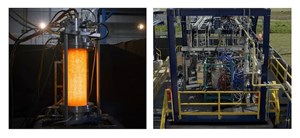News
Syzygy Plasmonics releases light-powered rector cell to produce H2
(PRNewswire)--Syzygy Plasmonics announced that the world's first light-powered reactor cell for industrial chemical reactions has met initial performance targets and is now available for order in stacks designed to produce up to 5 tpd of H2. Syzygy has completed more than 1,500 hours of testing of its Rigel cell to produce H2 from ammonia. Testing of the first-of-a-kind 200 kg/d light-powered ammonia eCracking cell began in late 2023 and is ongoing.
Climate goals in energy importing regions like Asia and Central Europe are forcing importers of liquified natural gas (LNG) to look for lower-carbon energy carriers. Many of them are turning to low-carbon ammonia as a solution. A portion of that imported ammonia will be cracked to produce H2 for hard-to-abate sectors like power generation and steel production. Conventional thermal ammonia cracking is energy intensive and emits nitrogen oxide (NOx) when ammonia is burned as part of the process.
Syzygy has pioneered a new technology that harnesses the energy from ultra-high efficiency artificial lighting to eCrack ammonia, removing the need for combustion. When powered by renewable electricity, Rigel cell stacks are designed to deliver no-NOx H2 from low-carbon ammonia.
"The testing at our Houston facility is going exceptionally well," said Syzygy CEO Trevor Best. "We're ready to deliver 5 tpd of H2 projects today. In 2025 we'll be ready for 10-t installations, and then for 100-t projects in late 2026."
With strong initial results, Syzygy has the data points needed to enter the market. These results also show a strong path forward to continue achieving even greater efficiency and performance in future reactor cell designs. Syzygy is establishing a strong efficiency baseline at the reactor cell level and adding the energy required for balance of plant equipment and processes to determine overall system efficiencies. Including the energy required for an entire eAmmonia cracking plant, test results show that Syzygy technology should be able to produce H2 using only 12 kWhr/kg in 2025. In 2026, the product roadmap calls for reducing that further to just 10 kWhr/kg, further improving efficiency and operating costs.


